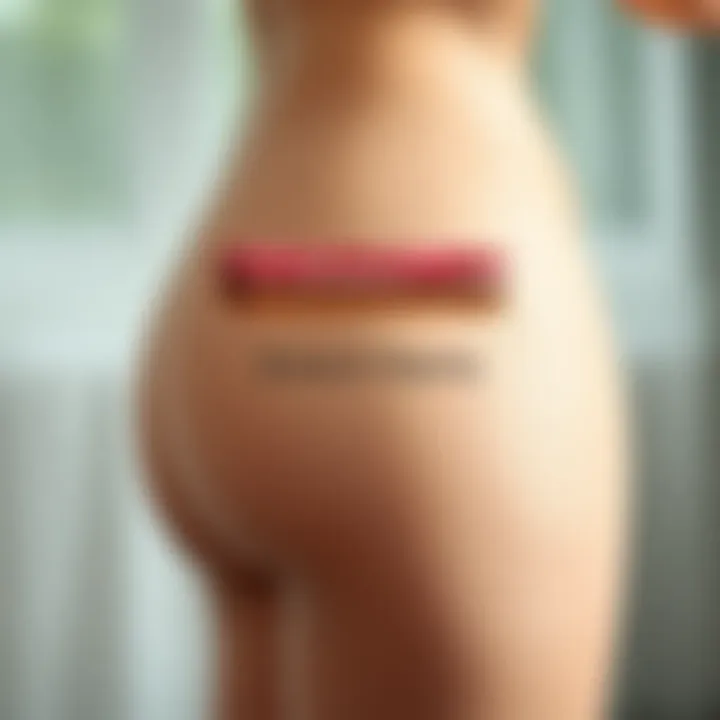Effective Strategies for Reducing Hip Stretch Marks


Intro
Stretch marks can be a frustrating concern for many individuals, particularly when they appear on visible areas like the hips. Understanding that stretch marks are a common skin condition is the first step to addressing them. They can result from various factors including rapid weight gain or loss, pregnancy, and hormonal changes. In this guide, we’ll explore effective strategies for diminishing the appearance of hip stretch marks. We'll deep dive into practical methods, both preventative and treatment-oriented, including topical solutions and professional interventions that can help get your skin looking better.
Insider Beauty Tips
While there’s no magic wand to vanish stretch marks completely, several beauty tips can help in reducing their visibility. Let’s unravel a few of these valuable strategies:
Beauty Hacks
- Moisturize Regularly: Keeping the skin hydrated can aid in improving its elasticity. Using oils such as coconut oil or shea butter can nourish the skin and may diminish the visibility of stretch marks.
- Massage Therapy: Regularly massaging the affected area can stimulate blood flow. This can also help the skin absorb topical products better.
- Exfoliation: Use gentle exfoliants in your skincare routine. Regular exfoliation can slough off dead skin cells and promote cell turnover, potentially reducing the appearance of marks over time.
Skincare Tips
- Look for Retinoids: When choosing creams, those with retinoids can boost collagen production, making skin appear more youthful and vibrant. Before applying, ensure to consult with a dermatologist, especially if pregnant or breastfeeding.
- Vitamin E Oil: This oil is often recommended for its skin-healing properties. Applying it directly on the marks may help in fading them gradually.
Treatment Options
Topical Applications
Topicals can act like a safety net when it comes to managing stretch marks. Here’s a closer look at some favorites:
- Bio-Oil: Known for its unique blend of ingredients, it’s said to improve the appearance of stretch marks and uneven skin tone.
- Mederma Advanced Scar Gel: This gel can often be found in pharmacies and claims to improve the texture and consistency of skin concerning scars, including stretch marks.
Professional Interventions
If home remedies don’t meet expectations, professional treatments provide a range of viable options:
- Laser Therapy: This helps in promoting collagen production in deeper skin layers, resulting in a reduction of marks over time.
- Microdermabrasion: By exfoliating the outer layer of skin, this method helps to rejuvenate the skin and reduces the visibility of stretch marks.
Remember, the effectiveness of treatments can vary from person to person. Always seek guidance from a qualified specialist to discuss what suits your skin type best.
Product Reviews
When it comes to tackling stretch marks, certain products stand out more than others in effectiveness and user satisfaction. Recommendations based on various criteria will guide you:
Skincare Products
- Palmer's Cocoa Butter Formula Massage Cream: A staple in many households, this cream is excellent for daily use.
- Stretch Marks Oil by Earth Mama: This oil combines natural ingredients and is often praised for its healing properties.
Makeup Products
If you want a quick fix to mask those marks while treating them, consider using:
- Dermablend Professional Cover Cream: A high-coverage foundation ideal for covering up blemishes and imperfections.
- Body Makeup by YSL: This can provide a temporary cover that lasts all day, perfect for special occasions.
Beauty Industry News
Staying updated with the latest in beauty can provide insights into what products and treatments are becoming popular. New launches might bounce up ways to deal with stretch marks more effectively:
- New Product Launches: Companies like Neutrogena are continuously developing innovative treatments specifically targeting skin issues like stretch marks.
- Brand Collaborations: When brands collaborate for special products, it means fresh ingredients and new approaches to old problems might be available.
The End
In summary, tackling hip stretch marks involves a combination of high-quality skincare, the right beauty hacks, and an understanding of treatment options. From moisturizing and massaging to advanced treatments, empowering yourself with knowledge and options can lead you on a journey towards smoother skin. Keep in mind, while achieving results takes time and commitment, an informed approach can make all the difference.
To delve into more resources, check out Wikipedia, Britannica, or forums on Reddit for community experiences.
Understanding Stretch Marks
Stretch marks, commonly known as striae, are a widespread skin concern. Understanding stretch marks is crucial, especially for individuals looking for ways to address their appearance. It’s not merely about aesthetics; comprehending the underlying factors can shape one’s approach to prevention and treatment. This article provides a comprehensive review of hip stretch marks, from their origins to effective strategies for addressing them.
These marks often arise during life changes such as pregnancy, weight fluctuations, or intense physical training. Awareness of how and why stretch marks develop could aid in finding the right solutions tailored to individual needs. Moreover, recognizing the emotional impacts of these skin changes can foster a proactive attitude toward skin health.
What Are Stretch Marks?
Stretch marks are streaks or lines that typically appear on the skin when it undergoes rapid stretching or contraction. They are often characterized by their initial reddish or purplish hue, gradually transitioning to a lighter shade over time. While commonly associated with pregnancy, stretch marks can occur in anyone, regardless of body type or age. In essence, they are an indication of the skin’s struggle to adapt to sudden changes.
Mechanism of Formation
The formation of stretch marks is tied to the skin’s elasticity, which is a reflection of collagen and elastin levels in the dermal layer. When the skin stretches quickly, the connective fibers can break, leading to the characteristic lines. Factors such as hormonal shifts or genetics may influence the skin’s ability to retain elasticity, sending a clear message: the more informed you are about these mechanisms, the better equipped you’ll be in adopting preventative measures.
Different Types of Stretch Marks
Stretch marks can be classified based on their appearance and cause. Some common types include:


- Striae rubra: These are fresh marks, typically red or purple. They are more prominent and often indicate recent skin stretching.
- Striae alba: Older marks, which are white or silvery, that have lost their original color as they mature.
- Striae gravidarum: Specifically associated with pregnancy, these stretch marks occur on the abdomen and hips.
Understanding the variations among stretch marks not only empowers individuals to identify their unique skin challenges but also informs their choice of treatment options. Each type deserves specific attention and care strategies to help minimize their visibility.
Causes of Stretch Marks
Understanding the causes of stretch marks is essential for anyone looking to manage their appearance thoughtfully. Stretch marks, although common, can be a source of concern for many. Grasping what triggers their formation lays the groundwork for both prevention and treatment. This segment reveals the multifaceted factors contributing to the development of stretch marks, ranging from hormonal changes to lifestyle behaviors.
Hormonal Changes
Hormones play a pivotal role in the elasticity of the skin. During significant life events, such as puberty or pregnancy, the body undergoes a whirlwind of hormonal shifts. These changes stir up collagen and elastin production, leading to variations in skin structure. When hormones, particularly corticosteroids, surge, they can weaken the skin's fibers and reduce its resilience against stretching. Notably, people often observe stretch marks during times of hormonal upheaval; girls during the teenage years and women navigating pregnancy can be more prone. Learning to identify these hormonal shifts can help inform a more proactive approach.
Genetics and Heredity
Genetics serves as an unyielding factor in the developing of stretch marks. If your parents bore these marks, there's a likelihood that you might, too. This hereditary aspect ties into skin type and the genetic predisposition to certain conditions. For instance, individuals with a family history of skin issues may notice that their skin is more susceptible to developing stretch marks under stress or rapid changes. While you can't alter your genetic makeup, understanding its influence can empower you to take more informed preventive measures.
Rapid Weight Changes
Rapid fluctuations in weight stand as a cornerstone cause of stretch marks. Whether it's gaining weight swiftly due to muscle growth or hormonal shifts, the skin may not have enough time to adjust. When skin stretches quicker than it can recreate itself, the integrity of the skin gets compromised, leading to the formation of these telltale lines. It's critical to focus on maintaining a healthy weight to give the skin ample time to adapt to any bodily changes. Consistency in weight management can help mitigate the odds of stretching—your body will thank you, not just for aesthetic reasons but for overall health as well.
Pregnancy and Childbirth
The journey of pregnancy is often a double-edged sword—beautiful yet challenging for the body. As the body accommodates a growing baby, the stretching of the skin particularly around the hips and abdomen can trigger stretch marks. Most women experience these during the later stages of pregnancy when weight gain accelerates. The physical transformation not only tests the elasticity of the skin but can also intertwine with emotional fluctuations, making the need for understanding more pressing. After childbirth, while the appearance of stretch marks might not completely disappear, they often fade over time. Expecting mothers should embrace this temporary phase by focusing on skin care and nourishment to support their bodies through this profound change.
"It is essential to recognize the underlying causes of stretch marks to effectively address them through actionable strategies."
Understanding the root causes of stretch marks allows individuals to work not only towards prevention but also a tailored response to treatment. By acknowledging how hormonal changes, genetics, rapid weight changes, and the life cycle of pregnancy contribute, one can adopt a more holistic view towards managing hip stretch marks. As you move ahead in your knowledge journey, consider embracing a blend of lifestyle adjustments and skin care practices to nurture your body through these challenges.
Preventive Measures
When it comes to tackling hip stretch marks, preventive measures hold a place of utmost importance. Stretch marks aren't just a result of skin tearing; they often signify changes in the body, such as hormonal adjustments or rapid weight fluctuations. Thus, addressing them before they appear can be a game changer for many individuals, especially those conscious about their skin.
The significance of prevention lies in its proactive nature. By adopting certain lifestyle habits and practices, one can not only reduce the likelihood of stretch marks forming but also promote overall skin health. These methods are not merely about looking better; they provide a holistic approach to wellness, emphasizing the importance of taking care of one's body inside and out.
Maintain a Healthy Weight
Keeping a stable weight is one of the most effective ways to prevent the onset of hip stretch marks. Rapid weight gain or loss can stretch the skin quickly, causing those telltale lines to emerge. Finding a comfortable weight and maintaining it through balanced eating and regular exercise creates a solid foundation for skin health.
Benefits of healthy weight management:
- Enhances skin elasticity: A stable weight helps the skin adapt without excessive stretching.
- Boosts confidence: Feeling good in one's own skin often translates into a positive self-image.
Hydration and Nutritional Balance
Staying hydrated is often downplayed but plays a crucial role in skin elasticity. Drinking enough water keeps skin tissues hydrated and can drastically decrease the chances of developing stretch marks. Additionally, ensuring that your diet is filled with vitamins and nutrients, particularly vitamins A, C, and E, can aid in skin health. These vitamins help in maintaining collagen levels, which contribute to the skin's elasticity and strength.
- Food for thought:
- Incorporating foods rich in Omega-3 fatty acids like salmon or flaxseeds can nourish the skin from the inside out.
- Leafy greens and berries are also beneficial due to their high antioxidants.
Skincare Routine to Enhance Elasticity
A well-formulated skincare routine can have a noteworthy effect on skin elasticity. The presence of certain ingredients in your lotions and creams can not only hydrate the skin but also promote collagen production. It's important to focus on products that are tailored for elasticity and moisture.
Essential products include:
- Emollients: Like shea butter, to lock in water and keep the skin soft.
- Exfoliants: Natural sugar or salt scrubs to gently remove dead skin and promote regeneration.
- Serums: Containing hyaluronic acid, which can draw moisture to the skin, ensuring it remains supple and elastic.
Regularity in applying these treatments can greatly influence skin resiliency and may shield it against stretch marks.
By weaving these preventive measures into daily life, the quest for smoother skin may become much easier, transforming skin health into a part of a broader lifestyle ethos.
Topical Treatments
Topical treatments play a crucial role in managing the appearance of hip stretch marks. These products can help reduce visibility and improve skin texture. Their application is easier for many people since they can be integrated into daily routines without the need for invasive procedures. When chosen correctly, they can provide benefits that not only target stretch marks but also nourish the skin overall. Understanding their effectiveness and proper usage can help individuals see real results on their journey toward smoother skin.
Moisturizers and Oils
Using moisturizers and oils is foundational in addressing hip stretch marks. Hydration is essential for skin elasticity, and well-hydrated skin is less likely to develop noticeable marks. Look for products rich in ingredients like shea butter, cocoa butter, or hyaluronic acid. These compounds can help lock in moisture and might enhance skin suppleness.
- Application Tips:
- Apply after a warm shower when skin is slightly damp to maximize absorption.
- Use in circular motions to stimulate circulation in the area.
In addition to traditional creams, natural oils such as almond or jojoba oil can be effective. These oils not only moisturize but also provide vitamins that may support skin regeneration. Regular use can create a protective barrier that helps shield skin from further damage.


Retinoids and Hyaluronic Acid
Retinoids, derived from vitamin A, are often touted as a powerhouse in skin care, especially when targeting stretch marks. They work by promoting cell turnover, helping to enhance collagen production. This can gradually reduce the visibility of existing stretch marks and also help in preventing new ones. Hyaluronic acid, on the other hand, is a superstar when it comes to hydration. It can hold up to 1,000 times its weight in water, making it an ideal addition to any topical routine aimed at plumping and smoothening skin.
- Considerations:
- Start with a lower concentration of retinoids to assess skin tolerance.
- Note that retinoids may increase sensitivity to sunlight; using sunscreen is crucial.
Combining retinoids with hyaluronic acid can provide a balanced approach—offering both rejuvenation and hydration. It's wise to consult with skincare professionals when incorporating these powerful ingredients to ensure they're right for your skin type.
Vitamin E and Other Natural Remedies
Vitamin E is often highlighted in discussions about skin health, primarily due to its antioxidant properties. It is believed to support skin healing and may help fade stretch marks over time. Regular application can nourish the skin, helping to maintain its elasticity and resilience.
- Other Natural Remedies:
- Rosehip oil: Known for its regenerative properties, it is rich in essential fatty acids and vitamin A.
- Centella Asiatica: Often found in creams aimed at scar treatment, this plant extract can promote healing and potentially improve the appearance of stretch marks.
While these remedies are gentle and natural, results can take time and consistency is key. Users should be patient as they may not see immediate improvement, but over time, natural ingredients can indeed deliver admirable results.
"Incorporating a blend of moisturizers, retinoids, and natural remedies not only tackles the appearance of stretch marks but fosters overall skin health, making it a win-win for your skincare regimen."
Professional Treatments
Professional treatments play a pivotal role in the journey to reduce the appearance of hip stretch marks. While at-home remedies can provide some relief, procedures administered by skin care experts often yield more significant and lasting results. These treatments, depending on the individual’s skin type and the severity of stretch marks, can harness advanced techniques to stimulate skin regeneration and enhance the overall appearance of the affected area.
Selecting a professional treatment often means considering your skin's unique needs, the state of the stretch marks, and consultation recommendations. Furthermore, these treatments can be meticulously tailored to address your specific goals, which might include not only reducing the stretch marks’ visibility but revitalizing the overall skin texture as well.
"Seeking professional help may feel like crossing a threshold, but it is often the bridge to regaining confidence and comfort in your skin."
Laser Therapy
Laser therapy has emerged as a frontrunner in the arsenal against persistent stretch marks. This technique involves focused beams of light that penetrate deep into the skin, targeting the affected layers. The heat generated stimulates collagen production, which is essential for skin elasticity and structure. Many individuals report noticeable improvements in the texture of their skin just a few sessions in.
One significant advantage of laser therapy is that it typically requires minimal downtime. Unlike invasive procedures, patients can often return to their daily routines shortly after treatment. However, it's essential to have realistic expectations. Not everyone will achieve 100% fading of their stretch marks, but many experience a marked improvement in the overall texture and tone of the skin.
Microdermabrasion
Microdermabrasion stands out as another viable professional treatment, utilizing a minimally abrasive instrument to exfoliate the skin's surface. During a session, tiny crystals gently buff away the outer layer of skin, unveiling a fresher complexion beneath. This rejuvenation process not only minimizes the appearance of stretch marks but can also provide a smoother and brighter look to your skin overall.
Regular sessions can accelerate cell turnover, promoting healthier skin over time. Clients often find that their skin looks and feels softer and more vibrant after this treatment. It's essential, however, to keep in mind that microdermabrasion is typically best suited for newer stretch marks; older marks may require more intensive treatments for effective results.
Chemical Peels
Chemical peels utilize an active solution to exfoliate layers of skin and stimulate cellular turnover. By applying a chemical solution, dead skin cells and damaged skin layers are removed, allowing fresh skin to come forth. This treatment can be particularly effective for enhancing elasticity, further empowering the skin to rebound from the effects of stretch marks.
There are various strengths of chemical peels. Light peels can provide subtle improvements and are suitable for maintenance, whereas deeper peels offer more dramatic results and often require recovery time. Consulting a dermatologist can help determine the best strength for your specific needs. After a chemical peel, skin may be sensitive and in need of proper hydration and protection for optimal recovery.
In summary, whoever dares venture into the realm of professional treatments will find an array of options designed to tackle hip stretch marks. Whether it’s the precision of laser therapy, the buffing away of microdermabrasion, or the rejuvenation from chemical peels, these methods can offer promising results. Understanding and selecting the right treatment through a specialist’s guidance can pave the path towards smoother skin and added confidence.
Home Remedies
Home remedies hold a special appeal for many, especially when it comes to addressing skin concerns like hip stretch marks. These natural solutions offer a sense of accessibility and comfort, often using ingredients readily available in one's kitchen or garden. They can be an excellent starting point for individuals looking to combat stretch marks without diving into more invasive treatments. Importantly, home remedies are often perceived as safer with fewer side effects, making them a popular choice for those hesitant about professional procedures.
Using natural ingredients can be therapeutic and can provide not only physical benefits but also a sense of empowerment in managing one's skin. However, while many home remedies are praised for their effectiveness, it's crucial to remember that results can vary significantly from person to person. Here we will focus on three specific home-based treatments: Aloe Vera and Coconut Oil, Sugar Scrubs, and Essential Oils.
Aloe Vera and Coconut Oil
Aloe Vera and coconut oil are two powerhouses in the world of natural skincare. Aloe Vera has long been celebrated for its healing properties. It’s rich in vitamins, enzymes, and amino acids that help nourish the skin. Its soothing and anti-inflammatory effects can make it particularly appealing for combatting stretch marks. When applied to the skin, aloe can promote healing, support moisture retention, and contribute towards improved skin elasticity.
Coconut oil, on the other hand, is known for its deep moisturizing properties. Its fatty acids penetrate the skin easily, providing hydration that can help prevent and diminish stretch marks.
To create a simple yet effective treatment, consider combining the two:
- Mix equal parts of Aloe Vera gel and coconut oil.
- Apply the blend to the affected areas, massaging gently until thoroughly absorbed.
- Allow it to sit on the skin for at least 30 minutes. Rinse off with lukewarm water.
Pro tip: Regular application, ideally twice a day, can lead to more noticeable results over time.
Sugar Scrubs
Exfoliation is a vital part of maintaining healthy skin, and sugar scrubs offer an excellent way to slough off dead skin cells that can accumulate over time. By removing these cells, you not only improve the appearance of your skin but also enhance the efficacy of any treatments you apply afterwards.
Sugar scrubs are simple to make and can be customized. Here’s a basic recipe:
- Combine 1/2 cup of sugar with 1/4 cup of olive oil or coconut oil.
- Add a few drops of your preferred essential oil for fragrance and additional benefits.
- Gently massage this mixture onto your hips in circular motions for about five to ten minutes.
- Rinse with warm water, and pat the skin dry.


The granules of sugar help exfoliate while the oil brings in moisture, creating an inviting aroma and a refreshing sensation. Regular use, perhaps once or twice a week, can help improve skin surface and may gradually reduce the appearance of stretch marks.
Essential Oils and Their Benefits
Essential oils are not just a trend; they are a treasure trove of potential benefits for the skin, including stretch marks. Oils such as lavender, grapefruit, and frankincense have properties that can help improve skin texture and elasticity, making them worthwhile additions to your skincare routine.
Using essential oils is straightforward:
- Dilute a few drops of your chosen oil with a carrier oil, such as jojoba, almond, or even coconut oil.
- Apply it directly to the stretch marks, rubbing in gently.
The benefits of essential oils extend beyond mere skin appearance; they also provide a calming and soothing experience when incorporated into your self-care rituals.
Before introducing new ingredients into your skincare routine, always perform a patch test to ensure there are no adverse reactions. While home remedies can be effective, it's crucial to manage expectations, as they may take time to yield visible results. Combining these remedies with a healthy lifestyle and skincare regimen may offer the best approach to minimizing stretch marks.
When to Seek Professional Help
When it comes to dealing with hip stretch marks, knowing when to tap into professional help can mark the difference between a simple skin concern and a pressing issue requiring adept intervention. Stretch marks, while they can often be a normal part of life, may sometimes progress to a state that needs more than home remedies or over-the-counter treatments.
Recognizing the right moment to consult with a dermatologist can empower individuals, enabling more effective management of these skin changes.
Signs of Severe Stretch Marks
Identifying severe stretch marks can feel like deciphering a riddle. They might not always be accompanied by pain or discomfort, but certain indicators can suggest it's time to seek assistance.
- Color and Texture Changes: Stretch marks often start as reddish, purple, or dark brown streaks before fading to white or silver. If these marks remain vibrant or change texture—becoming raised or deeply etched—it's a potential red flag.
- Rapid Progression: Suddenly appearing dense clusters of stretch marks can signal an underlying issue, warranting immediate attention.
- Symptoms of Discomfort: While stretch marks themselves are harmless, they can sometimes hint at significant skin changes, such as pruritus or unusual sensitivity in the surrounding areas.
- Accompanying Health Concerns: If other changes in skin or body health coincide with the emergence of new stretch marks, such as unexplained weight loss or hormonal fluctuations, it might be best to consult a professional.
In short, if stretch marks start to seem relentless or if they're paired with other symptoms, don’t hesitate to reach out to a specialist.
Consultation with Dermatologists
If severe stretch marks are noted, a visit to the dermatologist can provide critical insight and assistance. This professional can evaluate the severity of your stretch marks and also explore any underlying conditions contributing to their development.
During the consultation:
- Skin Evaluation: Dermatologists typically begin with a thorough examination, assessing the marks and overall skin health.
- Medical History Review: You may be asked about your medical history or lifestyle, as these can significantly influence skin conditions.
- Treatment Options: Based on your specific situation, they can recommend various treatment avenues, be it topical solutions, lifestyle recommendations, or professional procedures like laser therapys.
These experts not only provide tailored treatment plans but also help in demystifying any myths or misconceptions you may have about your skin. Reaching out for professional advice shouldn't be viewed as defeat. Rather, it's a step in the right direction towards achieving smoother, healthier skin on the hips.
Long-Term Management and Maintenance
When it comes to dealing with hip stretch marks, long-term management and maintenance play a pivotal role. It's not just about erasing those marks upon first sight; it’s about cultivating a consistent routine that promotes skin health over time. When individuals understand the importance of sustained efforts, the outcomes can be both gratifying and empowering.
One of the key benefits of long-term management is that it allows your skin to adapt and respond positively to treatments. Much like a garden, your skin requires ongoing care to flourish. The processes involved, from regular hydration to targeted treatments, support elasticity and may help prevent further stretch marks from forming.
Keeping in mind that our skin ages and evolves, it is crucial to stay updated on skin care products and methods that suit our changing needs. There’s no one-and-done solution; hence, staying informed allows us to nurture our skin adequately.
Regular Skin Care Updates
Regular skin care updates are essential for maintaining the health and appearance of your skin over time. This involves routinely checking in on what products and routines benefit your skin, particularly as it changes due to age, hormonal fluctuations, or environmental factors. Here are a few tips:
- Stay Current With Products: Not everything works forever. What might have been a miracle cream a year ago could become less effective now. Make it a habit to review what you’ve been using.
- Adjust to Seasons: Different seasons can have varied impacts on your skin. During colder months, opting for thicker moisturizers can help lock in hydration, whereas a lighter lotion might suffice in the summer.
- Consult Professionals: Sometimes, a conversation with a skincare professional, like a dermatologist, can provide insights into new products or approaches tailored specifically for your skin type.
Staying flexible and receptive to new information can make a significant difference, allowing you to adapt practices that yield the best results.
Lifestyle Adjustments for Lasting Results
The road to effective long-term management doesn’t lie solely in your bathroom cabinet. Lifestyle adjustments are equally integral. These changes can steer you towards healthier habits, which in turn benefits your skin’s resilience and appearance. Here are several strategies:
- Balanced Diet: A diet rich in vitamins and antioxidants - think colorful fruits and vegetables - can significantly improve skin health. Nutrients target skin integrity from the inside.
- Hydrate: Drinking ample water each day contributes not only to overall health but also keeps your skin plump and supple. Dehydration can accentuate stretch marks, so keeping water handy is a wise choice.
- Physical Activities: Regular exercise boosts circulation, providing skin cells with oxygen and nutrients. It also helps maintain a healthy weight, which may mitigate the onset of new stretch marks.
Incorporating these lifestyle adjustments can markedly enhance your skin’s ability to adapt and recover, providing not just immediate results but a foundation for lasting skin health. The journey toward smoother skin involves a holistic approach that combines physical, emotional, and product-based care.
Cautionary Advice
Addressing hip stretch marks requires carefully considered strategies. While there are a plethora of options available – both topical and professional treatments – it is crucial to bear in mind that not every method will work for everyone. Individual skin types vary greatly, and what proves effective for one person may not yield the same results for another. Therefore, it's vital to approach these treatments with a balanced mindset, recognizing their limits.
Understanding Treatment Limitations
When it comes to stretch marks, it is essential to understand that complete eradication is seldom possible. Treatments can significantly diminish their appearance, but results vary widely.
- Realistic Expectations: Familiarize yourself with the fact that many treatments aim for improvement rather than perfection. Enthusiasm is understandable but aligning expectations with reality is critical.
- Skin Type Variance: Different skin types respond differently. For instance, individuals with darker skin may experience hyperpigmentation or scarring from certain treatments. Understanding your own skin can help you choose the best approach.
- Time Factor: Treatments often require patience. For example, many topical retinoids take weeks or even months to show noticeable results. Remember, skin healing is not a race, and good things take time.
"Effective treatments for stretch marks can take time. Set a realistic plan and stick to it for better results."
The above considerations underscore the importance of choosing treatments wisely. Consulting with a dermatologist can help navigate this landscape.
Potential Side Effects of Treatments
As with many cosmetic treatments, potential side effects are an important consideration when deciding on a method for tackling hip stretch marks. Recognizing these can prepare individuals for any setbacks during their journey.
- Topical Treatments: Products containing strong active ingredients, such as retinoids, can sometimes lead to irritation or redness, particularly if not used as directed. This highlights the importance of following product guidelines carefully.
- Laser Treatments: Though effective, laser therapy may cause temporary discomfort and swelling. Additionally, there's a risk of changes in skin pigmentation or scarring, especially in individuals with darker skin tones. Consulting with a certified professional is critical.
- Chemical Peels: These can result in peeling and soreness, and individuals may need to limit sun exposure for a period afterward to avoid complications.
It is advisable to perform patch tests and consult a physician before embarking on any treatment plans. When in doubt, professional guidance can illuminate the safest paths forward, ensuring a more effective and secure experience.







